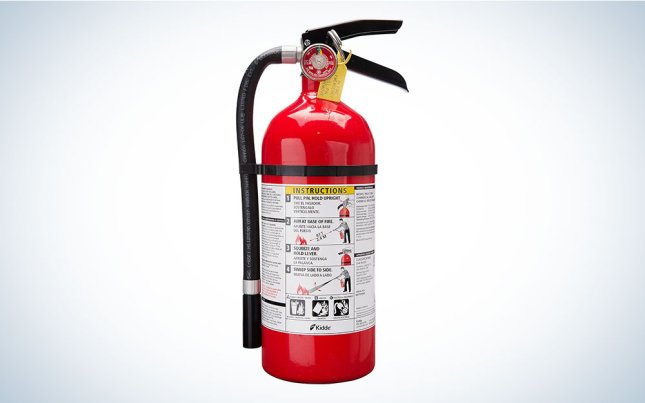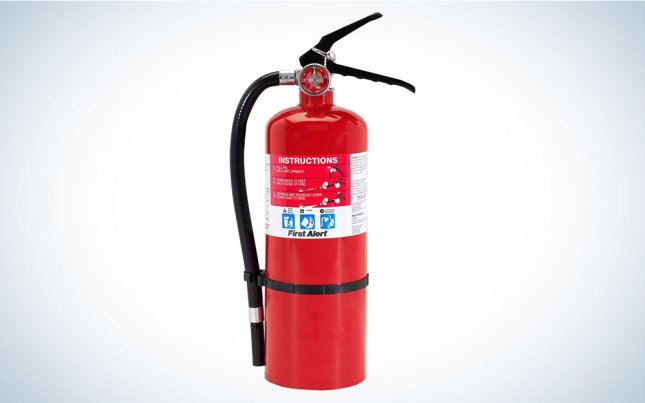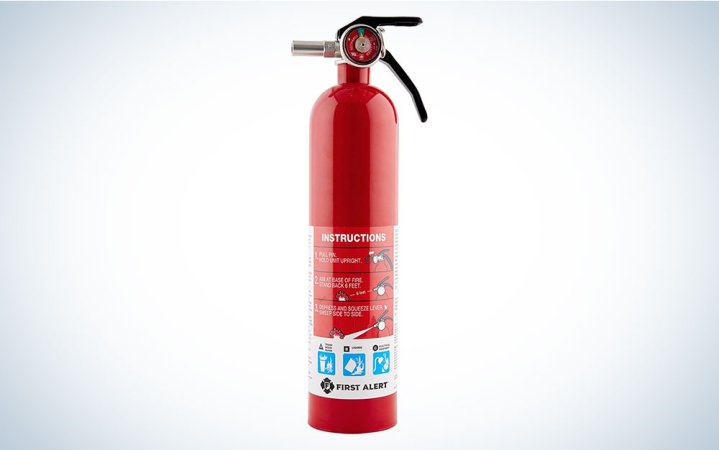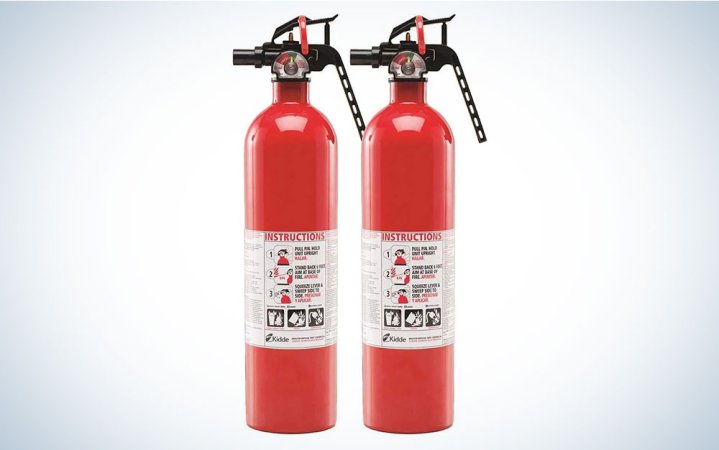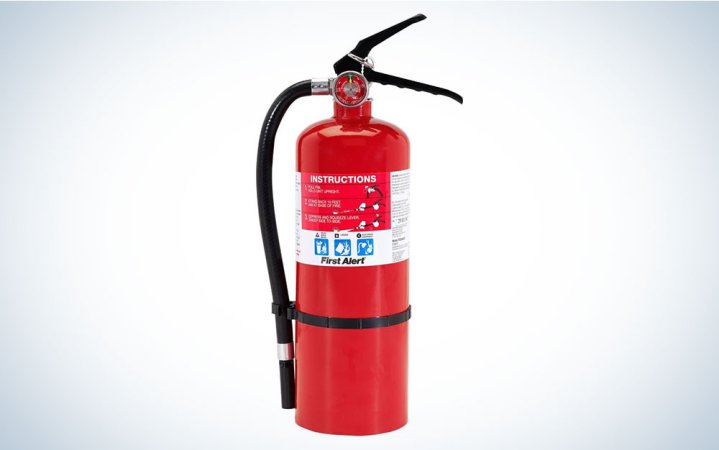We may earn revenue from the products available on this page and participate in affiliate programs. Learn more ›

Protecting your home with a fire extinguisher is easy and the right thing to do. But which one should you get? What does your home need to be safe? They may all be red and rounded, but the answer isn’t one size fits all. And regardless, if you live in a home or apartment, you should learn how to use one in an emergency because you never know when disaster can strike. Selecting a fire extinguisher without breaking the bank—and choosing one you need—is less of a dumpster fire than you think. The best fire extinguishers are easy to use and can diffuse baking busts, candle conundrums, science experiments gone awry, and other forays with fire.
- Best overall: Kidde Pro 210
- Best rated: First Alert HOME1
- Best value: Kidde Multipurpose Fire Extinguishers, 2 Pack
- Best design: FIRST ALERT PRO5
How we chose the best fire extinguishers
For each fire extinguisher we’ve selected, we’ll investigate the model’s construction, ease of use, and accessibility during an emergency. Don’t expect oddball products or large amounts of variation when it comes to fire extinguishers; you don’t want niche features or an odd look during an emergency.
The best fire extinguishers: Reviews & Recommendations
The following fire extinguishers are highly popular. In many ways, think of this as a review of the features and intricacies of the fire extinguishers that have consistently proven themselves the best rather than an attempt at uncovering new fire extinguishers. Also, remember that even the best fire extinguishers cannot contain all fires. Use good judgment, be prepared to leave a building, and call your local fire department as necessary.
Note that reading the UL rating for a fire extinguisher is confusing. We’ve included a guide to demystify these in our things to consider following the product write-ups.
Best overall: Kidde Pro 210
Pros
- Rechargeable design
- Includes UL-approved wall hanger
- Very lightweight
Cons
- Slightly expensive at full price
Why it made the cut: This lightweight fire extinguisher has a classic design and good utility.
Specs
- Classification: 2-A:10-B:C
- Weight: 7.5 pounds
The Kidde Pro 210 is a classic fire extinguisher designed to fight basic fires in your home from 10-15 feet away. It has a straightforward design with no surprises. It has a rechargeable design, and its pressure gauge is clearly visible. Kidde makes some of our favorite smoke detectors, so we consider this fire extinguisher an excellent addition to your home.
One thing to note is that while “4 lbs.” is the advertised weight, this weight is the weight of the active fire-fighting agent and not the full unit, which weighs approximately 7.5 pounds. Still, this should be very manageable for any adult who could use it during an emergency anyhow. As such, it is quite hard to find reasons to dislike this fire extinguisher, with the only possible negative being that the Kidde Pro 210 hits over $60 at full MSRP. If possible, grab it on sale.
Best rated: First Alert HOME1
Pros
- Highly affordable
- Very lightweight
- U.S. Coast Guard approved for marine use
Cons
- Not too powerful
Why it made the cut: After over 45,000 ratings, this fire extinguisher still reigns supreme.
Specs
- Classification: 1-A:10-B:C
- Weight: 4.5 pounds
It doesn’t take much to figure out why this offering from First Alert is so popular. It’s designed well and highly affordable. At 1-A and 10-B, the HOME1 does trade some power for the cost—in addition to being highly rated, this fire extinguisher is a great value pick—but it still packs the equivalent of 1.25 gallons of water in its small package and can handle 10 square feet of range top fire. You might also consider bringing this fire extinguisher on your next boat ride, as the Coast Guard has approved it for marine use.
Best value: Kidde Multipurpose Fire Extinguishers, 2 Pack
Pros
- Good for stocking the entire house
- Included wall mount
- Compact
Cons
- Some reviews note that the fire extinguishers can discharge in the box during delivery
Why it made the cut: Get two fire extinguishers for the price of one.
Specs
- Classification: 1-A, 10-B:C
- Weight: 7.6 pounds
It’s recommended that you have one fire extinguisher for every 500-600 square feet of living space. Buying two separate fire extinguishers can get pricey. This pack from Kidde comes with two fire extinguishers for the price of one. It includes an easy-to-read pressure gauge and can fight common fires involving fabrics, plastics, wood, flammable liquids, and electrical equipment. You can use the $37 of savings to get a carbon monoxide detector or a lil’ treato for yourself.
Best design: FIRST ALERT PRO5
Pros
- High power at an affordable price
- Ridged grip
- 12-year limited warranty
- Affordable despite power
Cons
- Mounting somewhat difficult
Why it made the cut: A powerful fire extinguisher with a rigid grip.
Specs
- Classification: 3-A:40-B:C
- Weight: 9 pounds
The first thing to note about the First Alert PRO5 is its intense UL rating. It contains the power of nearly four gallons of water and can cover a gas range of approximately 40 square feet, in addition to tackling your electronic appliances. If you have fire woes that are advisable for a person to tackle without professional help, this is the machine to help you with it.
It hits the mark for design due to this power and its above-par grip, which features a ridged design, perfect for lessening the chance of even wet fingers from slipping. Somewhat paradoxically, the mounting process is a bit trickier with this model, but that’s a one-and-done sort of thing and is (crucially) done when there is low pressure.
How to use a fire extinguisher
One thing you do not want to do is to have one of the best fire extinguishers but not know how to use it. You should check out the National Fire Protection Association (NFPA) guidance on fire extinguishers for in-depth, expert-vetted instruction. However, here are the footnotes, boiled down into a mnemonic you can remember:
The PASS Method
- Pull the pin.
- Aim at the fire.
- Squeeze the handle.
- Sweep the nozzle up and down, right to left around the fire.
It is also important to read the instructions that come with your fire extinguisher, preferably ahead of time. Also remember that you should never stick around and fight a fire bigger than what you can manage. Safe escape is the number one priority. Call a fire department to control and maintain the fire if the job is too big for you.
Another important thing to note is that NFPA advises against children learning how to use fire extinguishers. In the event of a fire, children should leave the building immediately and not stick around to fight the fire.
What to consider when buying the best fire extinguishers
While nearly all of the best fire extinguishers look somewhat the same, there are a few differences to consider, subtle as they are. When picking out your fire extinguisher from this list or on your own, think carefully about the following factors:
Classification and UL rating
While there are five main classes of fire extinguishers (A, B, C, D, and K) defined by the United States Fire Association via FEMA, you’ll typically see just A, B, and C in consumer-grade fire extinguishers:
- A — For “ordinary” combustible materials, typically dry, like wood and paper.
- B — For flammable and combustible liquids such as oil, greases, and gas.
- C — For electrical equipment.
Look for a UL rating as well. It will look something like the “3-A:40-B:C” found next to the First Alert PRO5. These numbers and letters indicate the strength and ability of the fire extinguisher to fight each type of fire based on the classifications above. Confusion in reading this label can be two-fold, partly due to the arcane appearance of the format and partly because the numbers are not straightforward. Here is how to read a UL label:
- We can see this is a multi-class A/B/C fire extinguisher since all three letters are shown in the rating.
- The number before the A represents its equivalent in 1.25 gallons of water for putting out material fires. This means that the PRO5 is equivalent to 3 X 1.25 = 3.75 gallons of water.
- The number before the B represents the area in square feet that it can handle Class B fires. The PRO5 can handle 40 square feet of oil and grease fires. Make sure the number before the B is at least as large as your stovetop.
- You will not find a number before the ‘C’. The ‘C’ just means that the fire extinguisher can handle Class C (electrical equipment) fires.
Buying a 2-A:10-B:C-rated fire extinguisher is a good place to start.
Fire extinguisher construction: Handle, hose, and weight
Don’t get too lost in the confusing technical details of your fire extinguisher and miss the physical realities. Look at the following aspects of your fire extinguisher with an equally critical eye:
Handle: Your handle should have a comfortable grip, with grooves or a ‘lip’ to keep your hands in place.
Hose: The fire extinguisher’s hose is its aiming mechanism. Look for a decent length and high flexibility so you can comfortably “sweep” the hose to douse your fire. Remember that if your hose gets punctured your fire extinguisher could become unwieldy or even dangerous to use. As such, look for a hose with a sturdy construction. Also note that not all fire extinguishers come with a hose, with some spraying directly from the spout.
Weight: The best fire extinguisher for you will be one that you, other members of the house, and guests will be able to hold and use efficiently. Remember that you will want to hold the fire extinguisher with one hand and grip the hose with the other, should it have one. Whenever possible, weaker members of the household should prioritize leaving before using a fire extinguisher.
Ease of use and familiarity
Most fire extinguishers look roughly the same and have similar features. This is largely by design. You may already know the feeling if you’ve ever had to call 911 or your region’s analog to the Emergency Service Number. Nothing feels right in an emergency; even your address (especially if you’ve moved in the last year) may slip your mind. Small details go when panic sets in.
Since most people are not serial fire extinguisher users, it is hard to become familiar with them. Get a red fire extinguisher with a pin, hose, and standard handle if you can. Quirky features are not extras if they might make you—or unfamiliar guests—hesitate in the face of an emergency.
FAQs
A fire extinguisher should cost between about $30 and $65. $50 is considered a reasonable price for a home fire extinguisher.
You should install your home fire extinguisher at a reasonable distance from where you expect fires might develop and the areas you want to protect. The entryway to your kitchen is a good example, so long as it is far enough away from the stovetop to not get in the way of the starting fire. If you live in a multi-story home, consider installing a fire extinguisher on every floor.
You should inspect your home fire extinguisher every year and consider having a professional inspection. A professional will tell you if your fire extinguisher needs to be replaced at this time.
Final thoughts on the best fire extinguisher
- Best overall: Kidde Pro 210
- Best rated: First Alert HOME1
- Best value: Kidde Multipurpose Fire Extinguishers, 2 Pack
- Best design: FIRST ALERT PRO5
Short of going to the lengths to fireproof your house with foil, the above fire extinguishers will give you the best fighting chance against the start of a fire you’re likely to get. After finishing your fire extinguisher shopping, check out our favorite home security systems for more property peace of mind.
